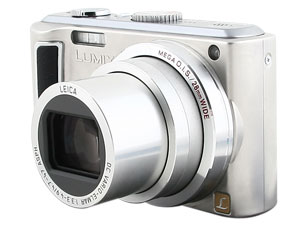 Why You Can Trust CNET
Why You Can Trust CNET Panasonic Lumix DMC-TZ4 review: Panasonic Lumix DMC-TZ4
It may have the looks of a compact camera, but the 8-megapixel Panasonic Lumix DMC-TZ4 has the power of a superzoom in a small package. It sports a large 10x zoom lens made by Leica, with a satisfying 28mm wide angle, and Panasonic's highly capable optical image stabilisation is a boon
It may have the looks of a compact camera, but the 8-megapixel Panasonic Lumix DMC-TZ4 has the power of a superzoom in a small package. It sports a large 10x zoom lens made by Leica, with a satisfying 28mm wide angle. It's available now for around £180 online.
The Good
The Bad
The Bottom Line
Design
The TZ4's styling has a certain retro lumpenness. The key to appreciating the design is to think of it not as an unnecessarily chunky compact, but as a slimmed-down superzoom. The large lens qualifies, and it is in fact more pocketable than most of the SLR-shaped snappers in that category. There's plenty of grip for the right hand, including a textured space for the fingers and an indent at the back that's uncannily well-fitted to our large right thumb -- your thumb-fit may vary.
Controls are straightforward. The usual four-way controls and menu button are joined by a handy quick menu button that gives one-touch access to shooting options such as white balance and ISO levels.
At the top of the camera is a mode dial that allows you to save two scene modes for quick access, and an easy-zoom button. This sends the zoom out to its full extent with one press, but it won't save any time, as zooming both manually or with the button takes 2 seconds.

The Panasonic Lumix DMC-TZ boasts a whopping 10x zoom
The sturdy frame is rounded off by a hinged door for the connections, including HD component out, with the SD/SDHC card slot in the bottom of the camera. The tripod bush is placed entirely off-centre, but at least this means the battery and memory card can be swapped without taking it off a tripod.
Our only real sulk about the TZ4's design is the underwhelming screen. The black border makes the ungenerous 64mm (2.5-inch) LCD look even smaller. The incremental backlight does make it easy to see, however, even when held up at different angles, and adjusts automatically to different lighting conditions.
Features
Panasonic's highly capable optical image stabilisation is essential here, with a long lens potentially magnifying the effects of camera shake. This system senses small vibrations and compensates to reduce blur in images. It can be on all the time -- mode 1 -- or just when the shutter is pressed -- mode 2. The difference is marginal, but we think mode 2 has the edge.
Manual control on the TZ4 is surprisingly limited: there's no shutter or aperture priority, let alone full manual. What you do get is a wide choice of shooting options, such as autofocus options including face detection, 9 area, 3 area, spot or high speed. There are two burst options, and a choice of aspect ratios: 16:9, 4:3 or 3:2.
The easy zoom button extends the lens to its full magnification
If that all sounds too much to think about, an intelligent scene selector will work out what sort of environment you are in, an intelligent auto mode will work out focus and exposure for you, and a digital red-eye removal system will make children and pets look less satanic.
In playback mode, images can be viewed in a thumbnail or calendar grid, and each picture magnified up to 16x. They can be cropped or resized to preset sizes.
Performance
The TZ4's automatic exposure deserves the intelligent name, exposing well in various lighting situations. Colour is natural and well-reproduced. The option to set a maximum ISO speed is very useful. There's no noise to speak of below ISO 800, so with image stabilisation on, this is a handy camera to have in darker conditions. It's worth tweaking the exposure compensation for best results, although without manual control there's some trial and error involved.
The size of the lens means there is some barrel distortion around the edges of images taken at the wide angle. There isn't any loss of focus or vignetting around the edges, with focus staying crisp overall.
Start-up time isn't particularly fast, because of the lens cycling out, but once it's started, shot-to-shot time is just over 1 second, which is pretty good. The burst mode manages a respectable 2 frames per second, but only for four shots. An unlimited burst mode is only marginally slower, so it's probably worth skipping the limited burst mode completely.
Battery life is excellent, with juice left after more than 300 test shots, including some using the flash. This sets the TZ4 in good stead with anyone looking for a powerful but portable superzoom to take on holiday.
Conclusion
The Panasonic Lumix DMC-TZ4 does a cracking job of bringing a powerful zoom and wide angle to those looking for point-and-shoot user-friendliness and portability. It's not the smallest camera in the world, but it's by no means the biggest either and benefits from a great lens. The Ricoh Caplio R7 is more compact, but we can't fault the TZ4 on anything, except perhaps the size of the screen.
Edited by Nick Hide


